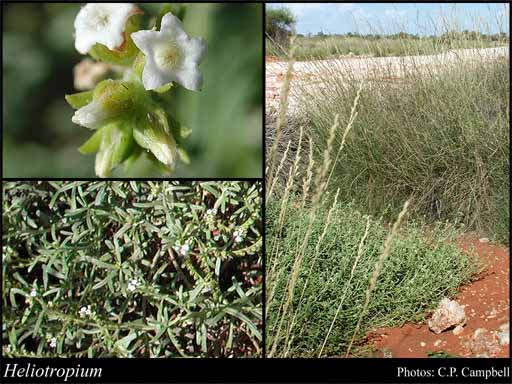- Reference
- Sp.Pl. [Linnaeus] 2:130 (1753)
- Name Status
- Current

Scientific Description
Common name. Heliotropes. Family Boraginaceae.
Habit and leaf form. Shrubs (rarely), or herbs; without essential oils. Autotrophic. Herbs annual to perennial; plants with neither basal nor terminal concentrations of leaves; to 1 m high. Self supporting. Helophytic, or mesophytic, or xerophytic. Leaves small to medium-sized; alternate, or opposite (rarely); ‘herbaceous’, or fleshy; petiolate to sessile; non-sheathing; not gland-dotted; simple; epulvinate. Leaf blades entire; flat; usually narrow, linear to lanceolate; elliptic, or oblong, or ovate, or obovate, or linear, or orbicular; attenuate at the base. Mature leaf blades abaxially glabrous, or pubescent. Leaves without stipules. Leaf blade margins crenate. Leaves without a persistent basal meristem. Leaf anatomy. Hairs present, or absent; glandular hairs present, or absent. Unicellular hairs present, or absent. Urticating hairs absent. Stem anatomy. Secondary thickening developing from a conventional cambial ring.
Reproductive type, pollination. Fertile flowers hermaphrodite, or functionally male, or functionally female. Unisexual flowers present, or absent. Plants hermaphrodite, or dioecious. Entomophilous, or pollinated by unusual means (sometimes cleistogamous); via hymenoptera.
Inflorescence and flower features. Flowers solitary, or aggregated in ‘inflorescences’; in cymes. The terminal inflorescence unit cymose (coiled at first). Inflorescences terminal, or axillary; of scorpioid cymes, simple or branched, rarely in a complex pseudodichotomous structure; not pseudanthial. Flowers pedicellate to sessile; bracteate, or ebracteate; bracteolate; minute to small; regular; 5 merous; cyclic; tetracyclic. Free hypanthium absent. Hypogynous disk present, or absent. Perianth with distinct calyx and corolla; 10; 2 -whorled; isomerous. Calyx present; 5; 1 -whorled; gamosepalous; blunt-lobed; imbricate, or open in bud, or valvate; somewhat unequal but not bilabiate, or regular; neither appendaged nor spurred; persistent, or not persistent; accrescent (sometimes), or non-accrescent. Calyx lobes linear (acute). Corolla present; 5; 1 -whorled; appendiculate (with a corona of scales from the throat protecting the nectar), or not appendiculate (usually); gamopetalous; lobed. Corolla lobes markedly shorter than the tube, or about the same length as the tube. Degree of gamopetaly 0.5–0.8. Corolla imbricate, or contorted; tubular (to salverform); regular; hairy abaxially, or glabrous abaxially; hairy adaxially, or glabrous adaxially; plain, or with contrasting markings; white, or cream, or pink, or purple. Fertile stamens present, or absent (when flowers female). Androecium 5. Androecial members unbranched; adnate (to the corolla); all equal; free of one another, or coherent (anthers contiguous to coherent, forming a cone over the stigma); 1 -whorled. Androecium exclusively of fertile stamens. Stamens 5. Staminal insertion midway down the corolla tube. Stamens remaining included; isomerous with the perianth; oppositisepalous; filantherous (to subsessile), or with sessile anthers. Filaments not appendiculate. Anthers separate from one another, or connivent to cohering; dorsifixed to basifixed; versatile; dehiscing via longitudinal slits; introrse; tetrasporangiate; unappendaged. Fertile gynoecium present, or absent. Gynoecium 2 carpelled. The pistil 4 celled. Carpels reduced in number relative to the perianth. Gynoecium syncarpous; eu-syncarpous; superior. Ovary plurilocular (entire, rarely grooved or ridged); 2 locular, or 4 locular (ostensibly). Locules secondarily divided by ‘false septa’. Gynoecium median. Ovary summit glabrous. Gynoecium non-stylate (stigma more or less sessile), or stylate. Styles 1; simple; from a depression at the top of the ovary; apical; not becoming exserted. Stigmas 1; large with a receptive disc surrounding a sterile cone or rarely lacking the cone. Placentation axile to basal. Ovules 2 per locule, or 1 per locule (ostensibly, separating into one-ovuled portions); horizontal to ascending; epitropous; non-arillate; anatropous, or hemianatropous.
Fruit and seed features. Fruit fleshy (at first), or non-fleshy; hairy, or not hairy (but usually papillose); a schizocarp. Mericarps 1–4; comprising nutlets. Seeds endospermic, or non-endospermic. Cotyledons 2. Embryo straight, or curved.
Special features. Corolla tube straight.
Etymology. From the Greek heliotropion, name applied in Greek and Latin to several plants, the flower-heads of which were believed to turn with the sun; from "sun" and "a turn, a solstice, when the sun appears to turn in its course".